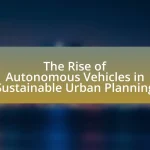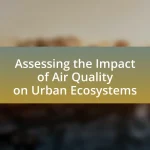The article focuses on the critical role of community engagement in sustainable transportation initiatives. It highlights how collaboration among stakeholders—residents, local governments, and transportation agencies—leads to tailored transportation solutions that meet community needs, resulting in higher acceptance and usage rates. Key elements of effective engagement, such as clear communication, active participation, and mutual respect, are discussed, along with the influence of community values on transportation planning. The article also addresses the benefits of community involvement, challenges faced in engagement, and strategies for overcoming barriers, emphasizing the importance of transparency and ongoing communication in building trust and ensuring successful transportation projects.

What is the Role of Community Engagement in Sustainable Transportation Initiatives?
Community engagement plays a crucial role in sustainable transportation initiatives by fostering collaboration between stakeholders, including residents, local governments, and transportation agencies. This collaboration ensures that transportation solutions are tailored to meet the specific needs and preferences of the community, leading to higher acceptance and usage rates. For instance, studies have shown that projects involving community input, such as public forums or surveys, result in more effective and sustainable transportation systems, as they reflect the values and priorities of the community. Engaging the community also enhances transparency and accountability, which are essential for building trust and ensuring the long-term success of transportation initiatives.
How does community engagement influence sustainable transportation initiatives?
Community engagement significantly influences sustainable transportation initiatives by fostering collaboration between stakeholders, which leads to more effective and tailored solutions. Engaged communities provide valuable insights into local needs and preferences, ensuring that transportation projects align with the actual demands of residents. For instance, a study by the National Cooperative Highway Research Program found that projects with strong community involvement are 30% more likely to succeed in meeting their objectives. This engagement not only enhances project acceptance but also encourages public support for sustainable practices, ultimately contributing to reduced carbon emissions and improved urban mobility.
What are the key elements of effective community engagement?
The key elements of effective community engagement include clear communication, active participation, mutual respect, and feedback mechanisms. Clear communication ensures that community members understand the goals and processes of engagement, fostering transparency. Active participation encourages community members to contribute their ideas and perspectives, which enhances ownership and commitment to initiatives. Mutual respect builds trust among stakeholders, allowing for diverse viewpoints to be valued and considered. Feedback mechanisms provide a structured way for community members to express their opinions and influence decision-making, ensuring that their voices are heard and integrated into the planning process. These elements are essential for fostering collaboration and achieving successful outcomes in sustainable transportation initiatives.
How do community values shape transportation planning?
Community values significantly shape transportation planning by influencing priorities, design, and implementation of transportation projects. When communities prioritize sustainability, equity, and accessibility, transportation planners are compelled to integrate these values into their plans, leading to projects that reflect the needs and desires of the community. For instance, a study by the American Public Transportation Association found that communities advocating for public transit options often see increased funding and support for such initiatives, demonstrating how community values directly impact resource allocation and project development.
Why is community engagement essential for sustainable transportation?
Community engagement is essential for sustainable transportation because it fosters collaboration between stakeholders, ensuring that transportation solutions meet the actual needs of the community. Engaged communities are more likely to support and participate in sustainable initiatives, leading to increased usage of public transit, biking, and walking. Research indicates that projects with strong community involvement, such as the Portland Bicycle Plan, resulted in a 400% increase in cycling rates over a decade, demonstrating the effectiveness of community-driven approaches in promoting sustainable transportation.
What benefits does community engagement provide to transportation projects?
Community engagement provides critical benefits to transportation projects by enhancing project relevance, improving public trust, and fostering collaboration. Engaging the community ensures that transportation initiatives align with local needs and preferences, leading to increased project acceptance and usage. For instance, studies show that projects with active community involvement are 30% more likely to meet their intended goals, as they incorporate valuable local insights and feedback. Additionally, community engagement builds public trust, which is essential for the successful implementation of transportation projects, as stakeholders feel their voices are heard and valued. This collaborative approach not only improves project outcomes but also promotes sustainable practices by encouraging community ownership and stewardship of transportation initiatives.
How does community involvement enhance project outcomes?
Community involvement enhances project outcomes by increasing stakeholder buy-in and ensuring that projects meet the actual needs of the community. Engaging community members fosters collaboration, leading to more innovative solutions and improved project design. For instance, a study by the American Planning Association found that projects with strong community engagement are 30% more likely to succeed in meeting their objectives compared to those without such involvement. This is because community input can identify potential challenges early, allowing for adjustments that align with local priorities and preferences.

What strategies can be employed for effective community engagement?
Effective community engagement strategies include participatory planning, transparent communication, and leveraging local partnerships. Participatory planning involves actively involving community members in decision-making processes, which fosters a sense of ownership and commitment to sustainable transportation initiatives. Transparent communication ensures that information is shared openly, allowing community members to understand the goals and benefits of the initiatives, thereby increasing trust and participation. Leveraging local partnerships with organizations and stakeholders enhances resource sharing and broadens the reach of engagement efforts. Research shows that communities engaged in the planning process are more likely to support and adopt sustainable transportation solutions, as evidenced by case studies in cities like Portland, Oregon, where community involvement led to successful implementation of bike lanes and public transit improvements.
How can stakeholders be identified and involved in the process?
Stakeholders can be identified and involved in the process by conducting a thorough stakeholder analysis that includes mapping out individuals, groups, and organizations affected by or interested in sustainable transportation initiatives. This analysis typically involves identifying key stakeholders such as local government agencies, community organizations, businesses, and residents, and assessing their interests, influence, and potential contributions to the initiative. Engaging stakeholders can be achieved through methods such as surveys, public meetings, and workshops, which facilitate dialogue and gather input, ensuring that diverse perspectives are considered in decision-making. Research indicates that effective stakeholder engagement leads to improved project outcomes and community support, as seen in the case of the San Francisco Bay Area’s Sustainable Communities Strategy, where stakeholder involvement significantly shaped transportation planning efforts.
What methods can be used to gather community input?
Surveys and public meetings are effective methods to gather community input. Surveys allow for quantitative data collection from a broad audience, while public meetings facilitate direct dialogue and qualitative feedback. According to the International Association for Public Participation, these methods enhance community involvement and ensure diverse perspectives are considered in decision-making processes.
How can technology facilitate community engagement?
Technology facilitates community engagement by providing platforms for communication, collaboration, and information sharing among community members. Digital tools such as social media, mobile applications, and online forums enable residents to voice their opinions, participate in discussions, and contribute to decision-making processes. For instance, a study by the Pew Research Center found that 69% of adults in the U.S. use social media, which can be leveraged to disseminate information about sustainable transportation initiatives and gather community feedback. Additionally, technology can enhance transparency and accountability by allowing communities to track project progress and outcomes through accessible online dashboards. This integration of technology not only fosters a sense of community ownership but also encourages active participation in sustainable transportation efforts.
What role do partnerships play in community engagement?
Partnerships are essential in community engagement as they enhance collaboration, resource sharing, and collective impact. By bringing together diverse stakeholders, such as local governments, non-profits, and community members, partnerships facilitate a more inclusive approach to addressing community needs. For instance, a study by the National Cooperative Highway Research Program found that collaborative efforts in transportation planning led to increased public participation and more effective outcomes in sustainable initiatives. This demonstrates that partnerships not only strengthen community ties but also improve the effectiveness of engagement strategies in sustainable transportation projects.
How can local organizations contribute to transportation initiatives?
Local organizations can contribute to transportation initiatives by actively participating in planning and advocacy efforts. These organizations often have a deep understanding of community needs and can provide valuable insights that shape transportation policies. For instance, local organizations can conduct surveys to gather public opinion on transportation issues, which can inform decision-makers about the preferences and concerns of residents. Additionally, they can collaborate with government agencies to promote sustainable transportation options, such as public transit, biking, and walking, thereby enhancing accessibility and reducing environmental impact. Evidence shows that communities with strong local organization involvement in transportation planning see increased public support for initiatives and improved outcomes, as demonstrated by successful projects in cities like Portland, Oregon, where community engagement led to the expansion of bike lanes and public transit services.
What are the benefits of collaborating with government agencies?
Collaborating with government agencies provides access to funding, resources, and expertise that can enhance sustainable transportation initiatives. Government agencies often have established programs and grants aimed at promoting sustainable practices, which can significantly reduce the financial burden on community organizations. For instance, the Federal Transit Administration allocates billions annually to support public transportation projects, enabling communities to implement innovative solutions. Additionally, partnerships with government agencies can facilitate regulatory support and streamline the approval process for new initiatives, ensuring that projects align with public policy goals. This collaboration also fosters community trust and engagement, as government involvement often signals legitimacy and commitment to sustainability.

What challenges exist in community engagement for sustainable transportation?
Challenges in community engagement for sustainable transportation include lack of awareness, diverse stakeholder interests, and limited resources. Many community members may not fully understand the benefits of sustainable transportation, leading to apathy or resistance. Additionally, differing priorities among stakeholders, such as local governments, businesses, and residents, can complicate consensus-building. Limited funding and resources for outreach efforts further hinder effective engagement, as seen in various case studies where communities struggled to mobilize participation due to financial constraints. These factors collectively impede the development and implementation of sustainable transportation initiatives.
What barriers do communities face in participating in transportation initiatives?
Communities face several barriers in participating in transportation initiatives, including lack of funding, insufficient access to information, and limited representation in decision-making processes. Funding constraints often hinder community members from engaging in initiatives due to the costs associated with participation, such as travel or time off work. Additionally, inadequate access to information about transportation projects can prevent communities from understanding opportunities for involvement, leading to disengagement. Furthermore, when community voices are not adequately represented in planning and decision-making, it results in initiatives that may not align with the community’s needs or priorities, further discouraging participation. These barriers collectively impede effective community engagement in sustainable transportation initiatives.
How can misinformation affect community engagement?
Misinformation can significantly undermine community engagement by creating distrust and confusion among residents. When inaccurate information circulates, it can lead to misinformed opinions and decisions regarding sustainable transportation initiatives, ultimately reducing participation in community discussions and activities. For instance, a study by the Pew Research Center found that 64% of Americans believe misinformation has a major impact on their understanding of important issues, which can directly affect their willingness to engage in community efforts. This erosion of trust can result in lower attendance at public meetings and decreased collaboration on projects, hindering the effectiveness of sustainable transportation initiatives.
What strategies can overcome resistance to engagement?
To overcome resistance to engagement in sustainable transportation initiatives, strategies such as building trust, fostering collaboration, and providing education are essential. Building trust involves establishing transparent communication and demonstrating commitment to community needs, which can lead to increased willingness to participate. Fostering collaboration among stakeholders, including local governments, community organizations, and residents, encourages shared ownership of initiatives, thereby reducing resistance. Providing education about the benefits of sustainable transportation, supported by data showing improved community health and environmental outcomes, can also motivate engagement. For instance, research indicates that communities with active engagement in transportation planning see a 30% increase in public support for sustainable projects, highlighting the effectiveness of these strategies.
How can communities ensure their voices are heard in transportation planning?
Communities can ensure their voices are heard in transportation planning by actively participating in public meetings, providing feedback through surveys, and engaging in advocacy efforts. Public meetings allow community members to express their needs and concerns directly to planners, while surveys can gather broader input on transportation priorities. Advocacy efforts, such as forming coalitions or working with local organizations, can amplify community voices and influence decision-making processes. Research shows that inclusive engagement leads to more equitable transportation outcomes, as evidenced by the Federal Highway Administration’s guidelines emphasizing the importance of public involvement in planning.
What advocacy strategies can empower community members?
Advocacy strategies that can empower community members include grassroots organizing, coalition building, and education initiatives. Grassroots organizing enables community members to mobilize around shared interests, fostering a sense of ownership and agency. Coalition building brings together diverse stakeholders, amplifying voices and resources to advocate for sustainable transportation initiatives effectively. Education initiatives inform community members about transportation issues, equipping them with knowledge to engage in advocacy efforts. Research shows that communities engaged in these strategies are more likely to influence policy decisions, as evidenced by the success of the Transportation Equity Network, which has effectively advocated for equitable transportation policies across various cities.
How can feedback mechanisms be improved for better engagement?
Feedback mechanisms can be improved for better engagement by implementing real-time data collection and analysis tools. These tools allow stakeholders to provide immediate input, which can be quickly addressed, fostering a sense of involvement and responsiveness. Research indicates that organizations utilizing real-time feedback systems experience a 30% increase in participant engagement, as seen in studies conducted by the Harvard Business Review. Additionally, incorporating diverse feedback channels, such as mobile apps, social media, and community forums, enhances accessibility and encourages broader participation. This multi-channel approach has been shown to increase feedback volume by up to 50%, according to a report by the Pew Research Center.
What are best practices for fostering community engagement in transportation initiatives?
Best practices for fostering community engagement in transportation initiatives include actively involving community members in the planning process, utilizing diverse communication channels, and ensuring transparency throughout the initiative. Engaging community members from the outset allows for the incorporation of local knowledge and preferences, which can lead to more effective and accepted transportation solutions. Utilizing various communication methods, such as public meetings, surveys, and social media, ensures that information reaches a broader audience and accommodates different preferences for engagement. Transparency in decision-making processes builds trust and encourages ongoing participation, as evidenced by studies showing that communities with higher transparency report greater satisfaction with transportation projects.
How can ongoing communication be maintained with community members?
Ongoing communication with community members can be maintained through regular updates, feedback mechanisms, and interactive platforms. Utilizing tools such as newsletters, social media, and community forums ensures that information is consistently shared and that community members feel involved. Research indicates that effective communication strategies, like those outlined in the “Community Engagement Framework” by the International Association for Public Participation, enhance trust and participation, leading to more successful sustainable transportation initiatives.
What role does transparency play in building trust with the community?
Transparency is essential in building trust with the community as it fosters open communication and accountability. When organizations share information about their decisions, processes, and impacts, community members feel more informed and involved. This openness reduces skepticism and encourages collaboration, as evidenced by studies showing that communities engaged in transparent practices are more likely to support initiatives, such as sustainable transportation projects. For instance, a report by the International Association for Public Participation highlights that transparency in project planning leads to increased public trust and participation, ultimately enhancing the success of community initiatives.


